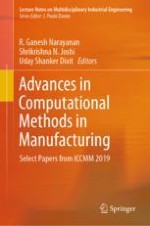2019 | Buch
Advances in Computational Methods in Manufacturing
Select Papers from ICCMM 2019
herausgegeben von: Prof. Dr. R. Ganesh Narayanan, Dr. Shrikrishna N. Joshi, Prof. Uday Shanker Dixit
Verlag: Springer Singapore
Buchreihe : Lecture Notes on Multidisciplinary Industrial Engineering
